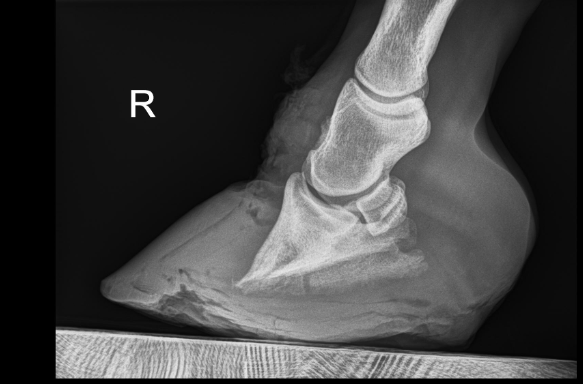 Springtime is an exciting time for equine enthusiasts. Warmer weather allows owners to pull off those winter blankets, enjoy trail rides and start utilizing the newly growing summer forages. The increase in forage availability can lead to issues with laminitis. Laminitis is the damage and inflammation of the tissue between the hoof and the underlying coffin bone. It can progress to founder, in which the hoof and coffin bone are separated, allowing the coffin bone to rotate, leading to severe pain. According to the UC-Davis College of Veterinary Medicine laminitis can be broken into three phases: developmental, acute, and chronic. In the developmental phase, the injury to the laminae is just beginning and horses generally do not show signs of pain. The Acute phase will last a few hours to multiple days with outward signs of pain and stiffness. The Chronic phase is much longer-lasting and is associated with a dislocation of the coffin bone. Treatment for laminitis can be challenging as once outward signs of pain are observed, the damage has already been done. Plenty of rest, limited demand of movement, and proper farrier visits can help mitigate the issues.
Springtime is an exciting time for equine enthusiasts. Warmer weather allows owners to pull off those winter blankets, enjoy trail rides and start utilizing the newly growing summer forages. The increase in forage availability can lead to issues with laminitis. Laminitis is the damage and inflammation of the tissue between the hoof and the underlying coffin bone. It can progress to founder, in which the hoof and coffin bone are separated, allowing the coffin bone to rotate, leading to severe pain. According to the UC-Davis College of Veterinary Medicine laminitis can be broken into three phases: developmental, acute, and chronic. In the developmental phase, the injury to the laminae is just beginning and horses generally do not show signs of pain. The Acute phase will last a few hours to multiple days with outward signs of pain and stiffness. The Chronic phase is much longer-lasting and is associated with a dislocation of the coffin bone. Treatment for laminitis can be challenging as once outward signs of pain are observed, the damage has already been done. Plenty of rest, limited demand of movement, and proper farrier visits can help mitigate the issues.
Recently, The University of Florida College of Veterinary Medicine has made great strides in research to help combat this crimpling disease. Through genetic testing and cellular observation, veterinary scientists have discovered that protein compounds such as keratin start to degrade when the disease begins. They also discovered that proteins such as metalloproteinases, compounds that support skeletal structure, could become overactive and degrade the hoof structure. Additional information on this research can be found in the resources below.
According to Dr. Dianne McFarlane, DVM at Oklahoma State University College of Veterinary medicine, overweight horses have a much higher risk of laminitis, due to increased feed intake and sugars in their diet. With the spring flush of forages, it’s easy for horses who have been on dry lots or in the stall during the winter months to overeat the new, tender plants, increasing their chances of high levels of sugars in the diet. Legumes, such as clovers, often contain a higher level of sugar than do grass. Therefore, moderate grazing is encouraged early in the year to not overload the digestive system. Smaller bred horses, like ponies, are very thrifty in their breed phenotype, allowing for higher efficiency of their feed intake. Breeds like the mustang, Morgan, and some types of Arabians are also generally thriftier in their genetic makeup and are more susceptible to adding extra weight.
Dr. McFarlane encourages producers to evaluate body condition of horses to gauge the general nutritional level. Body condition scoring of horses is a visual evaluation tool to observe the fat distribution of the animal. Scoring is numerically ranging from a score of 1-emaciated to 9-extremely fat. The desired condition of your horse can depend on many variables, including age, sex, workload, breed, and nutritional intake. It’s common to evaluate the fat distribution over several key areas, including the withers, croup, back, and neck. It may also be in the owner’s best interest to palpate over these areas to get a better idea of how much, or how little, fat distribution is present. Body condition scoring should be done periodically throughout the year but is easily observed daily.
–
Additional resources:
The Body Condition Score of Horses
Laminitis: The Story of how spring grass and over loving your horse can lead to disaster
UC Davis: Laminitis
Breakthrough laminitis research shows promise for the future
- 2026 Santa Rosa CountyRow Crop Production Meeting – January 22 - December 19, 2025
- Hay Quality and Quantity Considerations for Winter Feeding - September 5, 2025
- Managing Lice on Cattle - February 28, 2025
